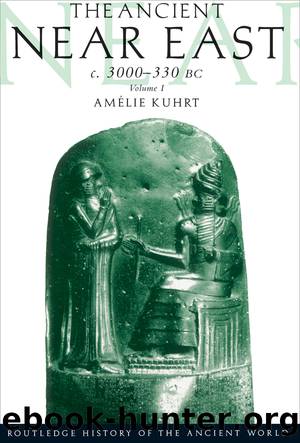The Ancient Near East by Amélie Kuhrt

Author:Amélie Kuhrt
Language: eng
Format: epub
Publisher: Taylor and Francis
Published: 1995-02-15T00:00:00+00:00
CAH
conventional
low
Amenophis III
1417-1379
1403-1364
1390-1352
Amenophis IV (= Akhenaten)
1379-1362
1364-1347
1352-1336
Smenkhare
1364-1361
1348-1345
1338-1336
Tutankhamun
1361-1352
1345-1335
1336-1327
Ay
1352-1348
1335-1332
1327-1323
Horemheb
1348-1320
1332-1306
1323-1295
The site of el-Amarna in Middle Egypt first focused attention on this period. The first discoveries were made in the 1870s, when some rock tombs and stelae were found. But it was the find of a large number of clay tablets, mainly written in Akkadian and representing the Egyptian imperial correspondence (the âAmarna lettersâ), that aroused real excitement. Intensive exploration of the site by British and German archaeologists followed and they unearthed the cityâs extensive remains: wealthy houses, palaces, temples and an artisansâ quarter (Petrie 1984; Davies 1903-8; Peet et al. 1923-51). The royal court used the site only briefly, and the later king, Ramesses II (dynasty XIX: 1290-1224 (1279-1213)), reused blocks from Amarna in his buildings at Hermopolis on the opposite side of the Nile (Cooney 1965; Spencer and Bailey 1983-92).4 The finds at Amarna brought to light two unusual features of Akhenatenâs reign: first, the human figure, especially the king himself, was represented in a very curious way; secondly, a new cult of the âAtenâ (the sun-disc) had come into existence and other Egyptian gods were apparently not worshipped. What were scholars to make of this?
One approach was to look more closely at the period following Akhenatenâs reign. It became rapidly clear that the king was not accepted into the later list of Egyptâs kings, his name and those associated with him were excluded from monuments, and the years of his reign were counted together with those of Horemheb, the former general, who became king at the very end of the dynasty. So the period was blocked out from the official record; when it was impossible to avoid a mention of Akhenaten (e.g. for dating purposes) he was simply called âthe enemyâ. This would only happen if something particularly appalling had happened. What could that have been? One possibility is to see whether the inscriptions of Akhenatenâs immediate successors contain any hints. The stele of Tutankhamun from Karnak (Bennett 1939) does, indeed, make some veiled allusions: sanctuaries throughout the land were destitute; the land was in chaos; Egypt had suffered military defeats; the gods were so enfeebled that they could not answer prayers. While due allowance must be made for the exaggeration inherent in the language of royal texts, it is clear that the previous reign was already being regarded with some horror. The situation had to be rectified and Tutankhamun says he did so, by rehabilitating the sanctuaries, giving them properties and staffs as of old and remaking divine images. Although the statements are vague and generalised, something of Akhenatenâs reign does emerge: he had turned the established Egyptian order effectively on its head.
But how and in what way? One of Akhenatenâs policies, that used to be thought quite incontrovertible, was that he neglected Egyptâs imperial holdings; some even argued that military action was against his religious principles. The argument was based on some of the Amarna letters. Several contain dire warnings to the Pharaoh against the treacherous activities of neighbouring rulers, and some repeatedly bewail the Egyptian kingâs failure to send troops.
Download
This site does not store any files on its server. We only index and link to content provided by other sites. Please contact the content providers to delete copyright contents if any and email us, we'll remove relevant links or contents immediately.
The Daily Stoic by Holiday Ryan & Hanselman Stephen(2708)
The Fate of Rome: Climate, Disease, and the End of an Empire (The Princeton History of the Ancient World) by Kyle Harper(2436)
People of the Earth: An Introduction to World Prehistory by Dr. Brian Fagan & Nadia Durrani(2346)
Ancient Worlds by Michael Scott(2103)
Babylon's Ark by Lawrence Anthony(2070)
Foreign Devils on the Silk Road: The Search for the Lost Treasures of Central Asia by Peter Hopkirk(2056)
India's Ancient Past by R.S. Sharma(1987)
MOSES THE EGYPTIAN by Jan Assmann(1972)
The Complete Dead Sea Scrolls in English (7th Edition) (Penguin Classics) by Geza Vermes(1840)
Lost Technologies of Ancient Egypt by Christopher Dunn(1797)
The Daily Stoic by Ryan Holiday & Stephen Hanselman(1768)
The Earth Chronicles Handbook by Zecharia Sitchin(1744)
24 Hours in Ancient Rome by Philip Matyszak(1678)
Alexander the Great by Philip Freeman(1648)
Aztec by Gary Jennings(1545)
The Nine Waves of Creation by Carl Johan Calleman(1520)
Curse Tablets and Binding Spells from the Ancient World by Gager John G.;(1510)
Before Atlantis by Frank Joseph(1483)
Earthmare: The Lost Book of Wars by Cergat(1467)
